BuddyFaith (talk | contribs) No edit summary |
Capefeather (talk | contribs) (rewrite) |
||
| Line 1: | Line 1: | ||
| − | '''Revisualization'''<ref>Janet Tsu. [http://www.capcom-unity.com/zeroobjections/blog/2013/10/17/phoenix-wright-ace-attorney-dual-destinies-localization-the-trials-and-tribulations-of-the-gameplay-mechanics-team Phoenix Wright: Ace Attorney – Dual Destinies Localization: The Trials and Tribulations of the Gameplay Mechanics Team]. Capcom Unity. Retrieved on 2013-10-17.</ref> is a |
+ | '''Revisualization'''<ref>Janet Tsu. [http://www.capcom-unity.com/zeroobjections/blog/2013/10/17/phoenix-wright-ace-attorney-dual-destinies-localization-the-trials-and-tribulations-of-the-gameplay-mechanics-team Phoenix Wright: Ace Attorney – Dual Destinies Localization: The Trials and Tribulations of the Gameplay Mechanics Team]. Capcom Unity. Retrieved on 2013-10-17.</ref> is a plot device used in ''[[Phoenix Wright: Ace Attorney: Dual Destinies]]''. It occurs at a critical point in a [[trial]], when the protagonist is backed into a corner and has to review his or her thinking to reach a decisive conclusion that turns the case on its head. Thematically, it is similar to [[Miles Edgeworth]]'s [[logic]] epiphanies in ''[[Ace Attorney Investigations: Miles Edgeworth]]'' and ''[[Gyakuten Kenji 2]]''. Mechanically, it is essentially a series of multiple choice questions about items and evidence connected to the case. There are unique responses to every answer, including the incorrect ones, and no [[penalty]] is incurred for choosing incorrectly. |
| − | |||
| − | Similarly to the [[Logic]] feature in ''[[Ace Attorney Investigations: Miles Edgeworth]]'' and ''[[Gyakuten Kenji 2]]'', the defense reviews the known facts and builds up a train of thought to reach a conclusion. The defense is presented with a series of facts of many kinds, such as items and evidence connected to the case, and must choose the correct one to advance the reasoning towards a final conclusion. |
||
| − | |||
| − | The music that plays when Revisualization is used is titled "'''Revisualization ~ Synaptic Resonance'''" (カンガエルート ~シナプスの共鳴). |
||
| − | |||
| − | ==List of Cases with Revisualization== |
||
| − | *[[The Monstrous Turnabout]] (Used by Apollo Justice) |
||
| − | *[[Turnabout Academy]] (Used by Athena Cykes) |
||
| − | *[[Turnabout for Tomorrow]] (Used by Phoenix Wright) |
||
| − | *[[Turnabout Reclaimed]] (Used by Phoenix Wright) |
||
==Name== |
==Name== |
||
| − | In the [[Japan]]ese version of the game, this process is called the "thought route" (カンガエルート, ''kangae ruuto'', lit. "Thought Route"). |
+ | In the [[Japan]]ese version of the game, this process is called the "thought route" (カンガエルート, ''kangae ruuto'', lit. "Thought Route"). The music that plays when Revisualization is used is titled "'''Thought Route ~ Synaptic Resonance'''" (カンガエルート ~シナプスの共鳴). |
==References== |
==References== |
||
Revision as of 16:30, 1 December 2013
Revisualization[1] is a plot device used in Phoenix Wright: Ace Attorney: Dual Destinies. It occurs at a critical point in a trial, when the protagonist is backed into a corner and has to review his or her thinking to reach a decisive conclusion that turns the case on its head. Thematically, it is similar to Miles Edgeworth's logic epiphanies in Ace Attorney Investigations: Miles Edgeworth and Gyakuten Kenji 2. Mechanically, it is essentially a series of multiple choice questions about items and evidence connected to the case. There are unique responses to every answer, including the incorrect ones, and no penalty is incurred for choosing incorrectly.
Name
In the Japanese version of the game, this process is called the "thought route" (カンガエルート, kangae ruuto, lit. "Thought Route"). The music that plays when Revisualization is used is titled "Thought Route ~ Synaptic Resonance" (カンガエルート ~シナプスの共鳴).
References
- ↑ Janet Tsu. Phoenix Wright: Ace Attorney – Dual Destinies Localization: The Trials and Tribulations of the Gameplay Mechanics Team. Capcom Unity. Retrieved on 2013-10-17.
| "Pleeeeease! Expand meeeeee!" | |
|---|---|

|
This article is a stub or is otherwise incomplete. You can help the Ace Attorney Wiki by expanding it. |
